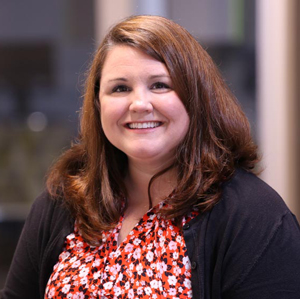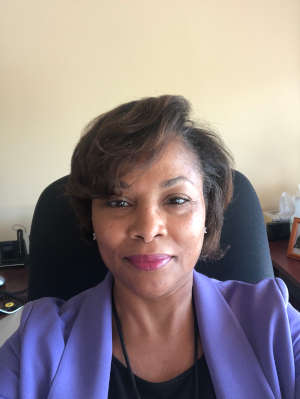2018 Impact Awards
Working Together for Quicker, Easier Captioning
Kennesaw State University collaborated with its captioning vendor to develop a better solution that faculty would actually use.
Category: IT Infrastructure and Systems
Institution: Kennesaw State University
Project: Working with Vendors to Create a Custom Captioning Solution
Project lead: Jordan Cameron, assistant director of academic web accessibility
Tech lineup: Ceilo24, Kaltura

Project team members (left to right) LaKesha Ross, Randall Dean, Veronica Trammell and Anushua Poddar
Kennesaw State University (GA) faced a challenge common to many universities: explosive growth in the number of online courses it offered and no easy and affordable way to scale up the closed captioning required to make all the course video and audio files fully accessible to all students.
With its previous captioning processes proving unsatisfactory, Kennesaw partnered with a vendor to develop a solution that provides speedy machine-generated captions and an embedded editor that allows faculty to do more of the captioning in a self-service mode. However, that level of faculty involvement came with another requirement: making the solution easier to use.

Jordan Cameron
"My mantra was always if it is going to be more difficult than YouTube, we don't want it," said Jordan Cameron, assistant director for academic web accessibility. "We kept working on usability with the vendor, and they were very responsive."
Kennesaw, which has more than 1,100 online courses in 70 fully online programs, had previously been using a speech-to-text appliance for machine-generated captions that student assistants would clean up and return to faculty. The process involved no fewer than 12 steps on the part of faculty, many of them quite time-consuming. "We want to meet the needs of students and be in line with federal guidelines," Cameron said, "but we just could not handle the volume anymore with our old systems."
There were other problems with the legacy solution. First off, it required a huge amount of server space to maintain. Kennesaw couldn't do any cloud storage with it, and no other vendor could partner to work on the captioning. "Every bit had to be done here with our student assistants, who are limited to working 20 hours per week," she said. Even with five student assistants, it took a long time to return files to faculty members, who found the whole process cumbersome. "We were having a hard time getting people to implement something that is federal law," Cameron added.
The legacy solution also required a substantial lead time for captioning while courses were being created. "As faculty were developing a new online course for the next year, we would advise them to do it six months in advance because it was going to take us a long time to get the videos captioned," she said. "We hated to do that."
The university realized it needed a solution to meet the following needs:
- Reduce the number of steps faculty must take to get videos captioned;
- Allow faculty to request machine-generated captions that they can edit;
- Allow faculty to request professionally captioned files, and;
- Remain within the prescribed budget.

Veronica Trammell
Cameron worked with a project team that included Veronica Trammell, executive director of learning technologies, training, & audiovisual outreach, as well as instructional designers who gave input on what the faculty members need and want. They also studied what others in higher education, such as the University of Minnesota system, had done to address the issue.
"We realized we wanted to make sure our system gave the faculty opportunities to work on their own captions if they wanted to," Cameron said. "Also, we couldn't afford to do every caption for our faculty, so we needed a system that would give us flexibility and more self-service functionality."
Because Kennesaw uses Kaltura Media Space for campus video storage, it chose to work with a company called Ceilo24, whose solution was compatible with Media Space. "We went with the company with the lowest price that was willing to build the features we wanted," Cameron said, adding that Ceilo24's solution required some changes before it would meet Kennesaw's needs. "We were honest with them and said it was not going to work for us [as is]. There were several problems with it. It was difficult to use." But she gives the company credit for being willing to make necessary changes. "I think they appreciated that it was making their product better."
One of the benefits of the solution they co-developed is that faculty do not have to download and upload files. They can create, edit and share videos directly in the captioning environment. They also can create and edit caption files as well.
Kennesaw also requested that Ceilo24 change its captioning to adhere to the DCMP (Described and Captioned Media Program) specification, a project of the U.S. Department of Education and the National Association of the Deaf. "We gave them a copy of the guidelines and said we need what you are doing to conform to these standards," Cameron recalled. "They edited their settings to align with that."
The new solution went live in 2017, and now more than 30 campuses in the University System of Georgia have the offering available to them. "When they saw how well it worked, the university system said we can give the rest of the universities in the system the opportunity to buy this as well," Cameron said.
Cameron noted that faculty members have increased their requests for professional captioning as well as do-it-yourself captioning since the new system was deployed. "Our Kaltura usage has gone up so much that we are paying a lot more," she said, "but it is worth it to know our videos are being captioned and more than that, the faculty is actively thinking about ways to meet the needs of diverse learners. That is the biggest benefit from this — that they are engaged in these conversations and making sure their instruction is encompassing all students. Those conversations were not happening on the same scale before this project."
Return to Campus Technology Impact Awards Home

